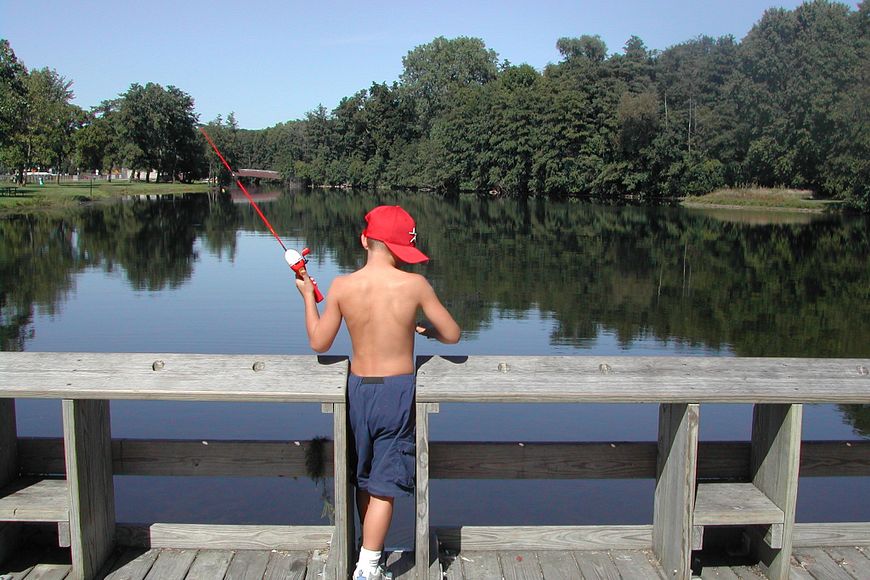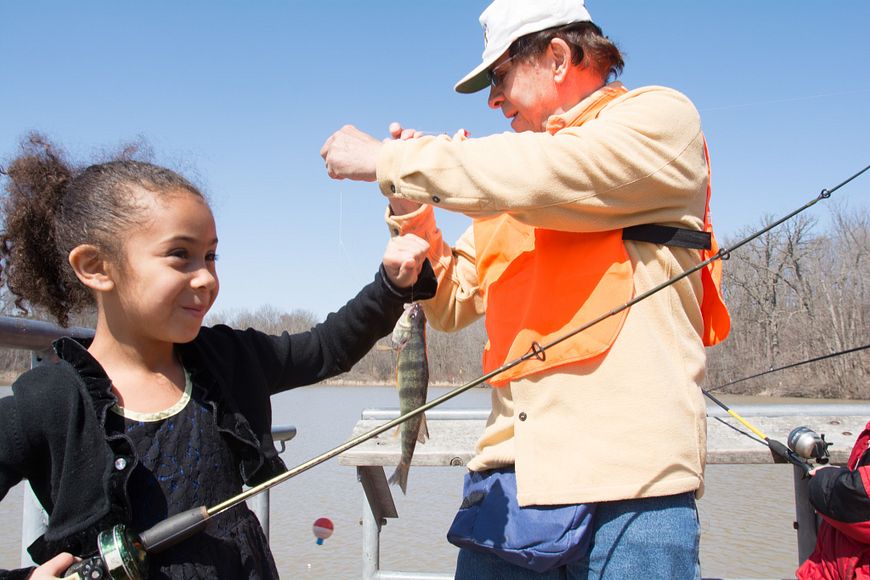IT'S REEL TIME
Learn a few ABCs of angling, and let the fishing begin
IN THIS ISSUE: Expanded fishing coverage
Lawrence Eslinger
 DNR FILES
DNR FILESGive a kid a fish, and it might keep their interest for a few minutes. Teach a kid to fish, and it just might instill in them a lifelong interest in the outdoors.
The old “teach a man to fish …” proverb has been altered slightly here, but it fits nicely with the thinking that perhaps now, more than ever, we could all benefit from some additional connection to the outdoors. And that applies to our children maybe more so.
Our lives have been altered dramatically for the past year with the uncertainties and limitations surrounding COVID-19. For many, these challenging times have made us feel all the more fortunate to live in a state with an abundance of outdoor opportunities.
One of those many opportunities is fishing. Wisconsin has more than 15,000 lakes and 84,000 miles of rivers and streams. Along with these many water resources is an abundance of publicly accessible ways to get out there to enjoy them, including by casting a line.
Research has shown that being near the water and fishing can be beneficial for your health. It can help lower anxiety by being in a relaxed environment, improve relationships by sharing the experience with family or friends, and build self-confidence as a result of gaining a new set of skills.
All of this can be done through fishing and done safely in the great outdoors!
For me, the most enjoyable aspects of fishing come from the sense of adventure and never knowing what you might experience. The time spent with family and friends is priceless, and the smiles, laughs and life lessons associated with the sport make it memorable.
So, give it a try. Better yet, take a child with you. My guess is you’ll create some lasting memories on those fishing adventures. And they just might get everyone hooked — pun intended — on going back for more.
LET’S GET FISHING
In general, the first Saturday in May marks the traditional start of the fishing season — that’s just around the corner on May 1 this year. Let’s talk about what you’ll need to get ready to go fish.
To someone with limited or no experience, getting started with fishing might seem overwhelming. But it doesn’t have to be. All it takes are a few easy steps.
First, determine whether you need a fishing license. In Wisconsin, anglers ages 15 and under are not required to have a fishing license. For first time buyers between the ages of 16 and 64, a license costs just $5. After the first license purchase, resident fishing licenses cost $20 annually.
Check the DNR website for details and to buy a license — dnr.wi.gov/gowild.
If you’d rather try before you buy, you can do that, too: June 5-6 is Free Fishing Weekend this year, with no license required to fish on state waters.
Second, determine the fishing gear you’ll need. This really depends on what species of fish you’ll be pursuing, but it’s probably best to start off simple, especially if you’ll be fishing with children.
You can get started with relatively inexpensive gear to pursue some of the state’s more abundant and aggressive fish species. That includes those in the sunfish family such as bluegill and pumpkinseed. See the graphic on Page 26 for more on basic gear.
As you hone your skills with practice and experience, there’s plenty of gear for upgrading, as well as more challenging fish species to pursue.
Bait can also be simple. A good all-around bait is a worm or nightcrawler, as many of Wisconsin’s fish species love to eat them.
You can even find your own bait and make that part of the fishing adventure — searching for nightcrawlers at night after a warm rain was always fun when I was a kid! Or try minnows, leeches and a variety of other natural bait, plus any number of artificial varieties.
BY BOAT OR BY SHORE
Thanks to the Public Trust Doctrine written into the State Constitution (article IX, section 1), Wisconsin’s lakes and rivers are public resources owned in common by the people of Wisconsin. This allows everyone in the state the right to boat and fish on all “navigable waters.”
On many of Wisconsin’s beautiful lakes, rivers and streams, there’s some form of public access. The DNR website is one way to find publicly accessible fishing areas near you, including great spots to take children, accessible spots for those with mobility issues and great urban fishing locations. Go to dnr.wi.gov and search “places to fish.”
The DNR also has a Stream Bank Protection Program that purchases property easements from private landowners to provide public fishing opportunities while also protecting critical stream bank habitats and water quality.
Specific public easement locations can be found by accessing Public Access Lands information here.
Once you find a spot, just be sure to read the signs at the trailheads, access sites or parking lots, and familiarize yourself with state and local laws and ordinances that might affect your use of these public lands.
Remember to be safe around the water. If you’re fishing from a boat, wear a life jacket, which is required by federal law for children under the age of 13 on federally controlled waters. And follow all other boating safety rules — dnr.wi.gov/topic/boat.
Even when fishing from shore, it’s a good idea to wear a life jacket, especially for young children who can’t yet swim.
KNOW THE FISH SPECIES
Wisconsin is home to more than 160 species of fish. Check out a few of the most commonly caught species here. That website has plenty of information, including details on common species, state fish records and resources to help you identify fish — the "Match Your Catch" Fish Wildcards are a hit with kids.
HANDLE WITH CARE
When fishing, it is important to keep in mind the following: A hooked fish should be fought as little as possible.
Fish are not intended to be out of the water for any length of time, and prolonged periods of struggle increase stress and fatigue in fish. The longer their struggle or time out of water, the lower their chance of survival upon release.
Consider having a fishing net with you to aid in a timelier capture and easier handling, while keeping the fish confined and in the water. Additionally, the net will help limit some of those experiences where the fish simply get away by shaking the hook before you can grab them.
All fish have fins. Some are spiny-rayed, some are soft-rayed and many have a combination of both spiny and soft fin rays. As such, it’s important to take precaution when handling fish — for your safety as well as for the safety of the fish.
A good rule to practice is to wet your hands before handling a fish. Fish have a protective outer mucus layer that can be removed with dry hands.
Support the fish with one hand under the belly while at the same time carefully laying down the fish’s dorsal fin — the one on the back of the fish — with the other hand. Be careful to avoid getting poked! On smaller to moderate-sized fish, you also can grab the fish gently by the body or nape, the area directly behind the fish’s head.
Do not squeeze the fish tightly and avoid touching the fish’s gills. Once the fish is secured, you can open its mouth and remove the hook by pulling it out with a needle-nose pliers or hemostats.
If the hook is hard to remove or is lodged in the fish’s gills or stomach lining, simply cut the line. The fish may very well shake the hook loose on its own later or expel the hook after digesting it. A fish’s stomach lining digests spiny fin rays from eating other fish and is very resilient.
By cutting the line, it may result in an uninjured fish, especially when compared with ripping the hook out and causing irreversible damage. That ultimately will lead to the death of the fish.
 BENJI PIERSON
BENJI PIERSONRELEASE OR KEEP
Before your fishing outing, decide whether you’ll want to harvest any fish or be fishing just for catch and release.
Make sure to check the fishing regulations to know which species, sizes and number of fish you may keep as well as what you must release. Whether you’re harvesting fish or not, remember to bring a camera to capture the excitement.
Catch-and-release fishing continues to grow in popularity as anglers realize the benefits of returning fish back to the water. For example, fish populations remain high and the size of fish may increase as older fish persist in the population.
When practicing catch and release, adhere to the fish handling techniques above and try to limit the fish’s fight time and exposure out of the water.
Snap a quick picture and lay the fish back in the water while gently supporting the fish until it recovers with the circulation of water and oxygen supplied through its gills. When the fish is ready to go, it will head off on its own.
Harvesting fish is also enjoyable and can be beneficial for the fishery in some cases, such as selectively harvesting smaller fish where there is an overabundance. Plus, a fish dinner with all the fixings is hard to beat.
Upon capturing a fish you will be harvesting, humanely euthanize the fish by applying an accurate, forceful blow to the fish’s head with a blunt instrument. Strike above the eyes, intended to impact on the brain.
Have a cooler of ice along to keep the fish fresh, as it is illegal to move angling-captured live fish away from a waterbody in a bucket of water.
EATING YOUR CATCH
Eating fish can be a part of a healthy, balanced diet while also supplying important vitamins and minerals. Fish, and fish oil, are primary food sources for healthy omega-3 fatty acids, which can help with preventing and managing heart disease.
Fish also are a product of their environment. They can take in pollutants through their uptake of food found within that environment.
The DNR has safe eating guidelines as well as specific consumption advisories to ensure you get the health benefits of eating Wisconsin’s fish while also reducing potential health risks from unwanted pollutants. Find details here.
FOLLOW THE LAW
Finally, before you set out, know the fishing regulations for where you plan to fish. The DNR manages fisheries with different regulation strategies, including through size and bag limits and season restrictions, to provide a variety of angling opportunities while protecting and enhancing fish populations themselves.
A fishing regulations booklet should be available anywhere that sells Wisconsin fishing licenses. There’s a downloadable PDF copy on the DNR website, along with a county-by-county guide searchable by waterbody name. Find both here.
Also be sure to follow all statewide bait rules and other fishing restrictions. It’s illegal to release any unused bait into the state’s waterways, a rule implemented to protect our waters and fisheries from harmful aquatic invasive species.
READY TO GO FISH
Now you’re set! When you’re out there fishing, do your part to respect the state’s resources, and respect other anglers by giving them space and being friendly. Remember to have fun and savor the experience.
It’s really not too much to get started fishing, and once you have what you need, it gets even easier. Soon, you may find yourself seeking more fishing adventure and creating lasting memories with those most important to you. I know I have.
Lawrence Eslinger is a DNR fisheries biologist. The DNR’s Claire Gaber, a communications specialist for fisheries, assisted with this report.
INFORMATION
For everything you need to know to get started fishing, check the DNR’s main fishing page — dnr.wi.gov/topic/fishing.

